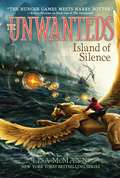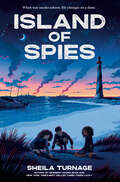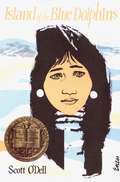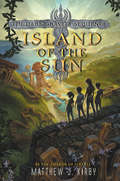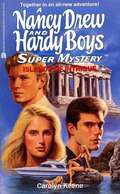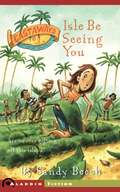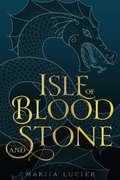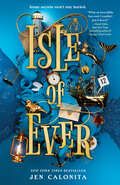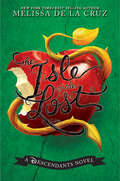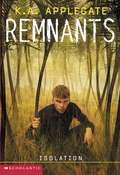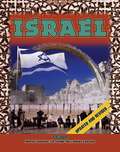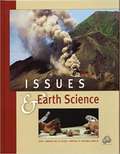- Table View
- List View
Island of Silence (The Unwanteds #2)
by Lisa McMannThe second book in the middle-grade dystopian fantasy series that Kirkus Reviews calls “The Hunger Games meets Harry Potter,” by New York Times bestselling author Lisa McMann.Following the life-altering events at the conclusion of The Unwanteds, the stark world of Quill and the magical haven of Artimé are now home to whoever wants to live there, whether they are Wanteds, Unwanteds, or Necessaries. In Artimé, Alex Stowe and his friends continue to hone their artistic magical spells while welcoming newcomers, wondering how long this peace between Quill and Artimé will last. Alex is stunned when Mr. Today comes to him with a very special request—one Alex questions his readiness for, until circumstances offer a dramatic answer. And back in Quill, Aaron Stowe, Alex’s twin, faces a very different path. Devastated by his loss of status after Justine’s defeat and seething with rage toward Alex, Aaron is stealthily planning his revenge and return to power. Alex and Aaron’s separate stories proceed with suspenseful pacing, colliding in a stunning climax that elevates sibling rivalry to epic proportions and leaves the fate of both worlds hanging in the balance.
Island of Spies
by Sheila Turnage"The Dime Novel Kids are spunky, spirited, smart, sassy—and so is Sheila Turnage&’s writing. It sizzles and sparkles." —Lauren Wolk, author of Newbery Honor Book Wolf Hollow From the Newbery Honor-winning author of Three Times Lucky comes a middle grade WWII spy mystery with as much humor and heart as high stakesTwelve-year-old Stick Lawson lives on Hatteras Island, North Carolina, where life moves steady as the tides, and mysteries abound as long as you look really hard for them. Stick and her friends Rain and Neb are good at looking hard. They call themselves the Dime Novel Kids. And the only thing Stick wants more than a paying case for them to solve is the respect that comes with it. But on Hatteras, the tides are changing. World War II looms, curious newcomers have appeared on the small island, and in the waters off its shores, a wartime menace lurks that will upend Stick&’s life and those of everyone she loves. The Dimes are about to face more mysteries than they ever could have wished for, and risk more than they ever could have imagined.&“Big, beautifully unfolding adventure and mystery, [and characters] who jump off the page and straight into your heart.&” —Kimberly Willis Holt, author of National Book Award Winner When Zachary Beaver Came to Town &“Charming and funny, [abounding in] codes and clues, spies, and double agents. —PW"Lively narration will quickly draw readers into the story, which twists and turns cleverly. —Booklist &“A little-known piece of American history [makes for] an entertaining saga of island life.&” —Kirkus&“Stick is the kind of protagonist I wish was my best friend . . . . I can&’t get enough of her.&” —Gennifer Choldenko, author of Newbery Honor Book Al Capone Does My Shirts
Island of the Blue Dolphins: Instructional Guides For Literature
by Scott O'DellThe gripping story of young Karana, who survives by herself for eighteen years on a deserted island off the California coast.<P><P> Newbery Medal winner
Island of the Sun
by Matthew J. KirbyPerfect for fans of the Percy Jackson and Seven Wonders series, Island of the Sun is the second book in an epic, fast-paced middle grade adventure trilogy by acclaimed author Matthew J. Kirby.Eleanor and her friends have shut down the mysterious Concentrator in the Arctic, but their mission is far from over. The earth is still spinning out of its orbit and growing colder by the day. Their only chance is to find the other Concentrators embedded around the world and deactivate them before it's too late.But doing so won't be easy. The Global Energy Trust has branded Eleanor, her mother, and their friends international terrorists and is tracking their every move. The G.E.T. will stop at nothing to harness the power of the Concentrators in order to preserve the select few people its leaders deem worthy, and Eleanor is soon forced to ask herself whether it's worth risking the lives of the entire human race for a slim chance to save it.
Islands of Intrigue (Nancy Drew & Hardy Boys SuperMystery #27)
by Carolyn KeeneNancy and Bess are vacationing in Greece at the same time as Joe and Frank Hardy are there pursuing a renegade American operative suspected of stealing missiles. Together, they set off on a spine-tingling Greek odyssey across a sea of duplicity, danger, and imminent destruction.
Isle Be Seeing You
by Sandy Beech Jimmy HolderI'm at the end of my rope! Like getting shipwrecked and surviving a hurricane weren't bad enough! Now I've got to support my sort of boyfriend's plan to get off this island, even though I think his idea's kinda lame. But with everything going so well between us, I don't want to rock the boat...er...make waves...well, you know what I mean! Especially with Evil Angela supporting Josh's plan all the way. I wish I knew what to do. The stakes are pretty high now. And I can't help wondering if maybe, just maybe, there's another way to get back home....
Isle of Blood and Stone (Tower of Winds)
by Makiia LucierEighteen years ago, two princes vanished. Now a riddle hidden on a mysterious map could chart a course towards the truth and the missing royals in this historical fantasy that's perfect for fans of Rachel Hartman and Tamora Pierce. Eighteen years ago two princes of the island kingdom of St. John del Mar were kidnapped and murdered, a deadly plot by the rival kingdom of Mondrago. Everyone knows the story, but for Elias, Mercedes, and Ulises, the aftermath of that tragic day is deeply personal. Elias grew up without his father, who was killed trying to protect the princes. Mercedes is half-Mondragan, leaving her to grow up in the shadow of del Mar’s hate. And Ulises, as the youngest and only remaining prince, inherited the throne meant for his older brothers. Now, the three friends just want to move on with their lives. But when two maps surface—each with the same hidden riddle—troubling questions arise. What really happened to the young princes? And why do the maps look like they were drawn by Elias’s father, whose body was never found? To discover what really happened that fateful day, Elias, Mercedes, and Ulises must follow the clues hidden in the maps, uncovering long-held secrets and unimaginable betrayals along the way. But the truth is dangerous, and not everyone wants it to come out. Isle of Blood and Stone is a sweeping fantasy full of intrigue and schemes, romance and friendship, and fearless explorers searching for the truth.
Isle of Ever (Isle of Ever #1)
by Jen CalonitaA New York Times Bestseller Read with Jenna Jr. Summer Reading List Pick!"[An] atmospheric fantasy ride."—Publishers Weekly, STARRED REVIEW"Fast-paced and satisfying."—School Library Journal, STARRED REVIEW"I couldn't put it down!"—Stuart Gibbs, New York Times bestselling author of the Spy School seriesTwo hundred years ago, an island disappeared. Benny has just two weeks to find it.Everly "Benny" Benedict and her mom have always managed to get by, though they're broke most of the time. But all that could change. Benny's just learned she's the sole heir to the vast fortune of Evelyn Terry, a mysterious ancestor from the 1800s!There's a catch, though. First Benny needs to play—and win—a game: following clues that are more than a century old, she must find her way to the tiny island Evelyn wrote about in her diary. It was somewhere off the shoreline of Evelyn's home town, but according to legend, it vanished long ago and hasn't appeared on maps for hundreds of years. Yet Benny has only a couple weeks to locate it.If she's successful, she'll collect the inheritance. But what if there's more than a fortune at stake in this game? What if Benny has to break an ancient curse to win?
Isle of the Lost, The-A Descendants Novel, Vol. 1 (Descendants)
by Melissa de la CruzEvil tree. Bad Apple? Twenty years ago, all the evil villains were banished from the kingdom of Auradon to the Isle of the Lost--a dark and dreary place protected by a force field that makes it impossible for them to leave. Stripped of their magical powers, the villains now live in total isolation, forgotten by the world. Mal learns from her mother, Maleficent, that the key to true darkness, the Dragon's Eye, is located inside her scepter in the forbidden fortress on the far side of the island. The eye is cursed, and whoever retrieves it will be knocked into a deep sleep for a thousand years. But Mal has a plan to capture it. She'll just need a little help from her "friends." In their quest for the Dragon's Eye, these four kids begin to realize that just because you come from an evil family tree, being good ain't so bad.
Isolation (Remnants Series #7)
by K. A. ApplegateThe end of the world has come . . . and gone. Three groups race to gain control of the ship and Mother, a computer that runs the ship and has been dictating the Remnants' every move. Mother is also the only chance the Remnants have to build a new Earth by harnessing her power to create environments. Billy knows Mother's true power firsthand--and it may be indestructible. The Remnants' conflict rushes toward something so finite, so unbelievable, weapons will be dropped, fighting will stop for a time . . . and new enemies will emerge.
Israel
by Adam M. GarfinkleIn 1948 the world witnessed an extraordinary event: the birth of Israel. After two millennia as a stateless people scattered across the globe and frequently persecuted by the societies in which they lived-most tragically during the Holocaust of World War II-Jews finally had a homeland. And the New Jersey-sized country was in Palestine, the ancestral land of the Jewish people. In the years since 1948, Israel has become the Middle East's most powerful, and most democratic, country. But the foundation and defense of the Jewish state ultimately came at the expense of a state for the Palestinians, another people with ancient ties to Palestine. For decades Israeli and Palestinian blood has stained the land, a string of peace initiatives collapsing amid the seemingly endless cycle of attack and retaliation. Resolving the conflict in a manner that preserves Israel's security remains an elusive goal not just for Israel, but also for the many countries with interests in the strategic Middle East, including the United States. Discusses the geography, history, economy, government, religion, people, foreign relations, and communities of Israel.
Issues & Earth Science
by University of California at Berkeley Lawrence Hall of ScienceNIMAC-sourced textbook
Issues & Life Science
by University of California at Berkeley Lawrence Hall of ScienceNIMAC-sourced textbook
Issues & Physical Science
by University of California at Berkeley Lawrence Hall of ScienceNIMAC-sourced textbook
Issues and Earth Science: Earth's Resources, Revised
by University of California at Berkeley Lawrence Hall of ScienceNIMAC-sourced textbook
Issues and Earth Science: Geological Processes, Revised
by Lawrence Hall of Science University of California BerkeleyNIMAC-sourced textbook <p>Where should we store our nuclear waste? Students learn about both gradual and sudden changes to the Earth’s surface, what causes them, and how they are monitored. They also explore how different kinds of rocks are formed and learn about some natural resources, where we find them, and how we use them. PE Assessment Example: Would you select one of the four suggested sites for storing nuclear waste? Explain. Use evidence from this unit to support your decision and identify any trade-offs. Geological Processes is part of Issues and Science three year middle school program, designed by SEPUP at the Lawrence Hall of Science. This six to seven week unit anchors the lessons around the the socio-science issue: Where should we store our nuclear waste? Investigative phenomena within the 18 activities connect back to the issue and storyline. This unit builds towards and assesses PEs ESS2-1, ESS2-2, ESS2-3, ESS3-1, ESS3-2. The Student Book guides students in exploring a socio-science issue and connected phemonena through a series of varied activity types. Activity types use one of twelve different instructional strategies to apply Science and Engineering Practices to specific Disciplinary Core Ideas and Cross Cutting Concepts. SEPUP's integrated literacy strategies help students process new science content, develop their analytical skills, make connections between related concepts, and express their knowledge orally and in writing. The built-in assessment system helps teachers identify students' strengths and weaknesses from the beginning of the unit. This allows them to adjust activities when needed so that all students get the best chance to build their knowledge and appreciation of science. At the back of the Student Book there is an Appendix containing additional resources for students, such as science skills, literacy strategies, and media literacy among others.</p>
Issues and Earth Science: Land, Water, and Human Interactions, Revised
by University of California at Berkeley Lawrence Hall of ScienceNIMAC-sourced textbook
Issues and Earth Science: Solar System and Beyond
by University of California at Berkeley Lawrence Hall of ScienceNIMAC-sourced textbook
Issues and Earth Science: Solar System and Beyond, Revised
by University of California at Berkeley Lawrence Hall of ScienceNIMAC-sourced textbook <p>What kinds of future space missions should we fund and conduct? Students take observations from their everyday life and build scientific models to try to understand how phenomena, such as changes in the moon’s appearance, seasons, and gravity work. Through data collection and analyzation students later use their understanding of what can be learned through space missions to determine the trade-offs of different proposed space missions. PE Assessment Example: Prepare a labeled diagram that includes a caption explaining how Earth’s tilt and its orbit around the Sun cause each of the following: a. changes in the angle of sunlight hitting the Earth’s surface. b. the seasons in the Southern Hemisphere to be opposite of the seasons in the Northern Hemisphere. Solar System and Beyond is part of Issues and Science three year middle school program, designed by SEPUP at the Lawrence Hall of Science. This five week unit anchors the lessons around the the socio-science issue: What kind of future space missions should we fund and conduct? Investigative phenomena within the 17 activities connect back to the issue and storyline. This unit builds towards and assesses PEs ESS1-1, ESS1-2, ESS1-3. The Student Book guides students in exploring a socio-science issue and connected phemonena through a series of varied activity types. Activity types use one of twelve different instructional strategies to apply Science and Engineering Practices to specific Disciplinary Core Ideas and Cross Cutting Concepts. SEPUP's integrated literacy strategies help students process new science content, develop their analytical skills, make connections between related concepts, and express their knowledge orally and in writing. The built-in assessment system helps teachers identify students' strengths and weaknesses from the beginning of the unit. This allows them to adjust activities when needed so that all students get the best chance to build their knowledge and appreciation of science. At the back of the Student Book there is an Appendix containing additional resources for students, such as science skills, literacy strategies, and media literacy among others.</p>
Issues and Earth Science: Weather and Climate
by University of California at Berkeley Lawrence Hall of ScienceNIMAC-sourced textbook
Issues and Earth Science: Weather and Climate, Revised
by University of California at Berkeley Lawrence Hall of ScienceNIMAC-sourced textbook <p>How does the weather affect people and how do people affect the climate? Students analyze weather, climate, and factors affecting them through the eyes of scientists who study Earth’s weather and atmosphere. They also investigate the links between human activity and changes in global climate. PE Assessment Example: Your friend claims that there is nothing that humans can do about global warming since Earth’s temperature is always slowly rising. a. Do you agree or disagree with your friend? Support your answer with evidence from this activity, and explain your reasoning. b. What other data, or evidence, would you like in order to better evaluate your friend’s claim? Weather and Climate is part of Issues and Science three year middle school program, designed by SEPUP at the Lawrence Hall of Science. This six to seven week unit anchors the lessons around the the socio-science issue: How does the weather affect people and how do people affect the climate? Investigative phenomena within the 17 activities connect back to the issue and storyline. This unit builds towards and assesses PEs ESS2-5, ESS2-6, ESS3-5, ETS1-3. The Student Book guides students in exploring a socio-science issue and connected phemonena through a series of varied activity types. Activity types use one of twelve different instructional strategies to apply Science and Engineering Practices to specific Disciplinary Core Ideas and Cross Cutting Concepts. SEPUP's integrated literacy strategies help students process new science content, develop their analytical skills, make connections between related concepts, and express their knowledge orally and in writing. The built-in assessment system helps teachers identify students' strengths and weaknesses from the beginning of the unit. This allows them to adjust activities when needed so that all students get the best chance to build their knowledge and appreciation of science. At the back of the Student Book there is an Appendix containing additional resources for students, such as science skills, literacy strategies, and media literacy among others.</p>
Issues and Life Science
by Barbara Nagle Manisha Hariani Donna MarkeyAs you examine the activities in this book, you may wonder, "Why does this book look so different from other science books I've seen?" The reason is simple: it is a different kind of science program, and only some of what you will learn can be seen by leafing through this book!
Issues and Life Science
by University of California at Berkeley Lawrence Hall of ScienceNIMAC-sourced textbook
Issues and Life Science, 2nd Edition
by SEPUP Lawrence Hall of Science University of California at BerkeleyScience textbook
Issues and Life Science: Body Systems, Revised
by Lawrence Hall of Science University of California BerkeleyNIMAC-sourced textbook
